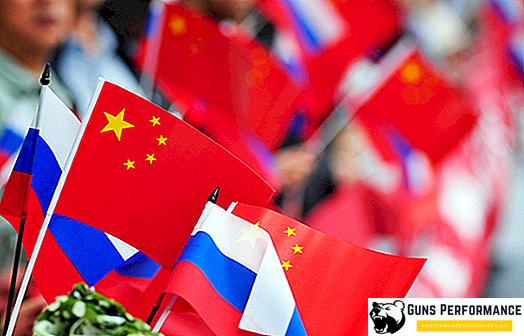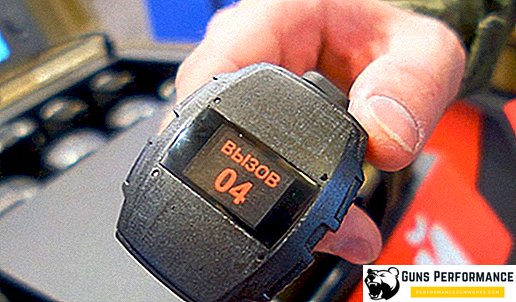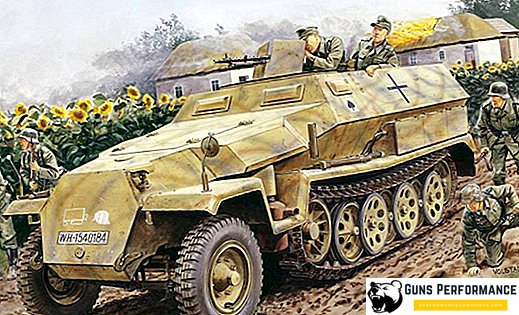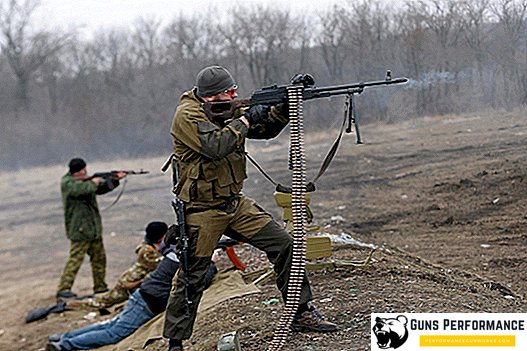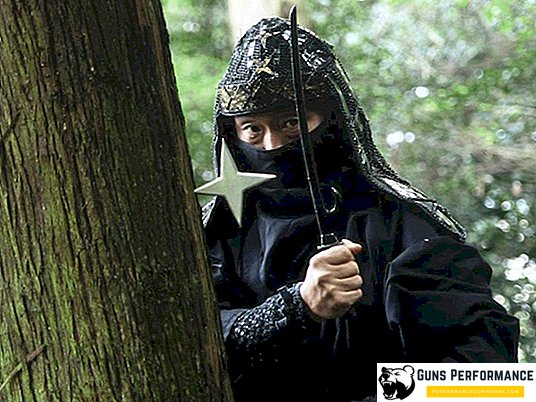
Shuriken is an extensive and very large group of Japanese throwing weapons designed for concealed carry. Sometimes it was used for striking in melee, as a piercing or cutting weapon. The name "shuriken" is translated as: "the blade is hidden in the hand."
It is curious that of the variety of Japanese edged weapons, it was shuriken and the traditional sword-katana that became the most famous and popular. And if with regard to the katana this looks absolutely fair and justified, then the loud world fame of the shuriken causes some bewilderment. The reason for the fame of such throwing weapons is very simple: thanks to modern cinema and anime, the shuriken has become a real "calling card" of the mysterious Japanese medieval murderers and spies - ninjas. Although, this view is not entirely true.

There are a huge number of varieties of shuriken, they differ in their shape, size, weight and method of manufacture. There are special features when using different types of these weapons. All shurikans can be divided into two large groups:
- bo-shuriken;
- syakens
The last group includes well-known to all of us in the movies "ninja stars".
Masters often put various mystical signs on the shuriken in order to attract powerful otherworldly forces to their side in the upcoming battle. In general, it can be said that shuriken was a very common type of throwing weapon in medieval Japan and was used not only by ninjas, but also by samurai. Therefore, the technique of its use was taught in almost all well-known Japanese martial arts schools.
Today, shurikens can be bought at regular gun shops in Europe and the USA. Although, in some countries, the sale of these weapons is prohibited. According to the Russian legislation (according to GOST), the length of shuriken rays should not exceed 8 mm, otherwise it will be considered cold weapons.

However, before proceeding to the description of this weapon and its classification, a few words should be said about the history of its occurrence.
Weapon history
It should be immediately noted that in Japan, throwing weapons (spears, darts, axes) did not become as widespread as, for example, in Europe. In the early periods, the most common projectile were stones that were thrown with the help of Hesihaikas, the Japanese sling. In historical treatises there is a description of how warriors in battle threw arrows or short Wakizashi swords into the enemy.

The first descriptions of throwing techniques are found in the Kojiki, a treatise that was written in the seventh century of our era. This document is about how to throw stones at the enemy. In another ancient Japanese source, Manueshi, the techniques of throwing arrows are depicted. Shuriken is first mentioned in the Osaka Castle War Tale, and in this same work it tells how the warrior Tadamas threw a short wakizashi sword at his opponent. Later it was this man who became the founder of the shuriken jutsu style.
In the chronicles of the XII century, there is often a description of the use of stones in battles. There were even special units of warriors, whose main task was to throw stones at the enemy. This was called "indzi-uti" or "stone-throwing battle." Similar tactics were often used later, during the internecine wars of the XIV and XV centuries. The warriors who participated in such battles were called "Mukai Tsubute-no-Mono", which means "advanced stone-meters".

Already at the end of the XIII - second half of the XIV century, the stones began to be replaced with special metal projectiles - indzi-yari ("stones-spears"), which in their form resembled a spear tip. Around the XVI-XVIII centuries, tsubute appeared - metal plates of a round or octagonal shape with a sharpened edge. It is likely that the indzi-jari became the forerunner of the bo-shuriken, and the tsubute in the future turned into syaken.
Most likely, the bo-shurikans appeared earlier than the well-known “star-syakens”. Even the very meaning of the word shuriken — the blade hidden in the hand — suggests that the first samples of this weapon resembled a blade rather than a polygonal star.
Although, it is quite possible that the bo-shurikans evolved from ordinary everyday objects that could be adapted for throwing in a duel. Some of them retained the names of their “ancestors” in the names: ari-gata (needle form), kugi-gata (nail form), tango-gata (knife form).
Tsubute were very common weapons, references to it are found in the so-called ninja treatises. Naturally, they were not the main weapon of a warrior, tsubute was thrown into the unprotected parts of the body of the enemy, seeking to hurt him or at least distract him.
By the middle of the Edo era, a kind of martial art, like throwing shurikens, shurikenjutsu, had already appeared in Japan. It is likely that it was formed from the more ancient art of throwing a spear - bujutsu. Although, it should be noted that the origin of shuriken still remains a mystery. This is primarily due to the fact that the art of shurikenjutsu was secret.

Shurikans had a number of weighty advantages, which determined their wide distribution. Firstly, this weapon had a small weight and size, which made it possible to carry it covertly and use it suddenly for the enemy. Secondly, shurikens were cheap, their production did not take much time and did not require high qualification from the blacksmith. For shuriken one could take not the highest quality steel. In this case, a well-trained fighter could hit the enemy with a shuriken at a fairly decent distance. In addition, this weapon could also be used in close combat (especially bo-shuriken) as a knife, stylet or brass knuckles.
Classification
To give a general description of shuriken is problematic, because it has a large number of varieties of weapons, which are very different in appearance and characteristics. As mentioned above, the shuriken throwing weapons are divided into two large groups: the bo-shurikens and syakens.
Bo shuriken or bojo shuriken. This is a type of cold throwing weapon, which has the form of a rod, round, octagonal or tetrahedral section. As a rule, the bo-shuriken were sharpened at one end, but there are also instances with double-sided sharpening. These deadly sticks could have a length of 12 to 25 cm and a weight of 30 to 150 grams. The shape of the bo-shuriken could be very different: rod-shaped, wedge-shaped, spindle-shaped, resemble a needle, knife or nail. Currently, more than 50 forms of this weapon are known.

The technique of using bo shurikens has been studied in many Japanese martial arts schools. So not only ninja spies, but samurais also very diligently studied the secrets of using shuriken in battle.
Syakens (or kuruma-ken, which translates as "sword-wheel"). This type of missile weapon, made in the form of a thin metal plate of a star-like or round shape with a sharp-edged edge. The diameter of such a plate could be from 100 to 180 mm. This weapon had a different thickness: from very small (less than 1 mm) to quite significant (about 3 mm). Thin and light syakens are easier to throw, but their range and accuracy are lower. Moreover, such weapons are difficult to cause serious damage to the enemy. Heavy "stars" had better ballistics and penetrating properties, but it was harder to throw them. Therefore, the rate of fire decreased. Sometimes the thickness of shaken decreased from the center to its edges. This design improved the ballistic characteristics of the weapon, but complicated its manufacture.

During production, the flat metal plate was uniformly quenched, and then rays were formed (if, of course, a star was made). And then sharply honed them.
In the center of such a plate, a hole was usually made, which improved the aerodynamic properties of this weapon, moreover, it allowed carrying the shuriken on a rope like a bunch of keys. In addition, the hole facilitated the removal of these weapons when stuck in anything (in a tree or a samurai head). By the way, thanks to a more advanced aerodynamic form, the syakens had a greater range of destruction than the bo-shurikens. At the "stars" it was about 12-15 meters, and the sharpened rod could be thrown just 7-8 meters.
By the way, "stars" were really more popular with ninjas, samurai preferred to use direct bo-shuriken. There are a huge number of varieties syakenov (not less than fifty). First of all, they are distinguished by their shape: round, six-pointed, quadrangular, three-beam and others. Their names - just like bo-syurikens - are associated with one or another martial arts school, which used them most often.
The variety of sizes and shapes of both bo-shurikens and sykens is largely due to different techniques of their use, which, by the way, continues today in Eastern martial arts schools. It should also be understood that there was no common standard for products at that time, so each blacksmith made unique products with their own size and shape. In addition, in the manufacture of shuriken, of course, the individual characteristics of the fighter, as well as his preferences, were taken into account.
How Shurikans Used
Written sources that have come down to our day describe various ways of using shurikens. Throws are made from different positions using different trajectories. Naturally, the techniques of throwing various types of shuriken also have their differences. In addition, each martial arts school had its own methods of using these weapons.
If we talk about the technique of working with bo-shurikans, then they identified two main techniques: a roll without a turn and a roll with a turn.

Usually, the bo-shuriken was clamped between the thumb and index finger, so that its blunt end lay at their base. Then the weapon was thrown with force towards the enemy. A well-thrown shuriken should fly along a trajectory as close as possible to a straight line. Rotation when throwing tried to minimize. It was much easier to throw bo-shuriken, sharpened on both sides.
Syaken usually threw a series, while the projectile twisted brush. Among the masters of the possession of the shuriken was such a popular saying: "One inhale-exhale - five knives." According to other sources, a well-trained warrior could throw five “stars” in 10–15 seconds. Thus trying to compensate for the small depth of the damage caused by their number. Given the maximum range of the throw, the defender had about 3-4 seconds before the enemy approached the distance of a sword or spear strike. Sometimes the cutting edge of the shuriken was coated with poison, a technique that was especially loved by ninjas.
The rotational movement allowed this weapon to maintain stability, to fly farther and more accurately hit the target.

The main target for the shuriken was the face, eyes, throat, limbs, and other parts of the body that were not protected by armor.
Ninjas really loved sakens, although, of course, they were never the main weapon in the arsenal of these elusive warriors. It should be noted that in the ninjutsu instructions that the researchers were able to detect, there is practically no description of the methods of throwing shurikens. This fact can be interpreted in two ways: either this skill was so secret (you can recall shurikjutsu) that its secrets could not be trusted even to paper, or each master had his own technique. Given the wide distribution of these weapons among the Japanese military elite, the second explanation looks more preferable.
It is believed that the ninja warrior should have been able to throw "stars" from absolutely any position: standing, sitting, lying, on the run. They were taught the same skill to use both hands, to throw weapons under different trajectories, to snatch the shurikens from any storage places with lightning speed (from the belt, armlets, clothing cuffs). Today we know about the seven basic methods of throwing this weapon, the nine secret methods and the eight medium difficulty used by the ninja.
These medieval Japanese reconnaissance scouts used shurikens not only as throwing weapons, it was convenient to cut holes in the walls and screens with sharp-pointed “asterisk”, hook nails, and make holes for hidden observation.

Shurikens were usually worn in stacks, 8-10 pieces each, wrapped in cloth. Sometimes hid in pockets, sleeves and even hair.


